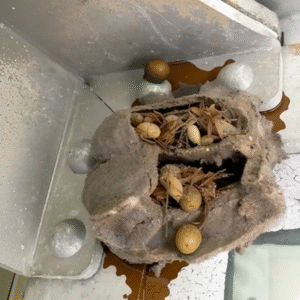The rescuers at the Heart of the Forest animal center were left both puzzled and intrigued when they received a tiny creature unlike any they had seen before. This small animal was covered in black fur, but its overall appearance was so unusual and indistinct that it immediately sparked curiosity among the rescue staff. The photos of the newborn quickly spread across social media, igniting a wave of guesses from people all over.
Some speculated it could be a kitten abandoned in the woods, others thought it might be a squirrel, while some even compared it to a miniature teddy bear because of its fuzzy, delicate appearance.
The baby animal’s features were so unclear and ambiguous that even experienced animal rescuers struggled to identify what species it belonged to at first. Despite its small size and fragile state, the little creature had already captured the hearts of many people following its story, who eagerly awaited news about its identity and condition. After careful examination and observation, the rescuers discovered that the mysterious animal was actually a domestic rabbit, estimated to be only about three to four days old. When she arrived at the rescue center, the baby rabbit had some light scratches on her body but was generally in a stable condition considering the circumstances.
What made this story even more extraordinary was the unusual way the rabbit came to be at the rescue center. Unlike most rescued animals, she was not brought in by a human being but by a kind-hearted dog who had found her and carefully carried her to safety. This remarkable act of animal compassion astonished the rescue workers and deeply touched the hearts of thousands of people who read about the story. It quickly became a powerful and heartwarming symbol of care and empathy in the natural world — a reminder that sometimes compassion can transcend species boundaries.
The mystery of how such a tiny domestic rabbit ended up alone in the forest remains unanswered. Domestic rabbits are rarely seen living in the wild, especially not alone and not in areas without local breeders or domestic populations. Unlike wild rabbits, which are born with fur and their eyes open, domestic rabbits are born blind, hairless, and completely dependent on their mother for survival during the first critical weeks of life. This makes domestic rabbits far more vulnerable and unable to survive on their own without immediate care and protection. To help inform and educate the public about these important differences between wild and domestic rabbits, the rescue team shared a series of comparison photos.
These images showed the clear contrasts between wild baby rabbits and domestic ones, highlighting the physical and behavioral differences that can help people recognize when a rabbit is truly in need of rescue and when it is best to leave the animal undisturbed in its natural environment. The rescue center’s goal with this educational effort was to raise awareness and encourage responsible and informed intervention, which could save many vulnerable animals in the future. Although the exact circumstances that led to the rabbit’s abandonment remain unclear, her story has already inspired many acts of kindness and generated widespread curiosity.
Under the care of the rescue team, the rabbit is now receiving the proper medical attention and nourishment she needs to heal and grow stronger. The protective instinct of the dog who found her likely played a critical role in saving her life during those early, dangerous hours. What began as confusion and uncertainty over the animal’s identity has since transformed into a moving story about the power of compassion and resilience. It reminds us that hope can come from the most unexpected places and that even the smallest, most vulnerable creatures deserve a chance to survive and thrive.
This incident also highlights the importance of paying close attention to the welfare of animals in our environment, especially those that appear to be alone or abandoned. It serves as a reminder to act thoughtfully and carefully when encountering wild or domestic animals, seeking expert advice when necessary. The rescuers’ experience shows that while it is crucial to protect wildlife, human intervention, when done correctly and with knowledge, can make the difference between life and death for many animals. The story of the tiny domestic rabbit, saved by a loyal dog and nurtured by dedicated rescuers, has now become a source of inspiration, teaching lessons about empathy, vigilance, and the unexpected bonds that exist between different species in nature.
In the end, what seemed like a simple rescue turned into a profound lesson about survival and kindness. It illustrates how instinct, compassion, and community support can come together to protect the most vulnerable. The little rabbit’s journey from uncertainty and danger to safety and care is a testament to the strength of life and the potential for goodness in the world around us. Her story continues to encourage people to open their hearts to animals in need and to recognize the importance of conservation and rescue efforts everywhere.
The rescuers at the Heart of the Forest animal center were left both puzzled and intrigued when they received a tiny creature unlike any they had seen before. This small animal was covered in black fur, but its overall appearance was so unusual and indistinct that it immediately sparked curiosity among the rescue staff. The photos of the newborn quickly spread across social media, igniting a wave of guesses from people all over. Some speculated it could be a kitten abandoned in the woods, others thought it might be a squirrel, while some even compared it to a miniature teddy bear because of its fuzzy, delicate appearance.
The baby animal’s features were so unclear and ambiguous that even experienced animal rescuers struggled to identify what species it belonged to at first. Despite its small size and fragile state, the little creature had already captured the hearts of many people following its story, who eagerly awaited news about its identity and condition. After careful examination and observation, the rescuers discovered that the mysterious animal was actually a domestic rabbit, estimated to be only about three to four days old. When she arrived at the rescue center, the baby rabbit had some light scratches on her body but was generally in a stable condition considering the circumstances.
What made this story even more extraordinary was the unusual way the rabbit came to be at the rescue center. Unlike most rescued animals, she was not brought in by a human being but by a kind-hearted dog who had found her and carefully carried her to safety. This remarkable act of animal compassion astonished the rescue workers and deeply touched the hearts of thousands of people who read about the story. It quickly became a powerful and heartwarming symbol of care and empathy in the natural world — a reminder that sometimes compassion can transcend species boundaries.
The mystery of how such a tiny domestic rabbit ended up alone in the forest remains unanswered. Domestic rabbits are rarely seen living in the wild, especially not alone and not in areas without local breeders or domestic populations. Unlike wild rabbits, which are born with fur and their eyes open, domestic rabbits are born blind, hairless, and completely dependent on their mother for survival during the first critical weeks of life. This makes domestic rabbits far more vulnerable and unable to survive on their own without immediate care and protection. To help inform and educate the public about these important differences between wild and domestic rabbits, the rescue team shared a series of comparison photos.
These images showed the clear contrasts between wild baby rabbits and domestic ones, highlighting the physical and behavioral differences that can help people recognize when a rabbit is truly in need of rescue and when it is best to leave the animal undisturbed in its natural environment. The rescue center’s goal with this educational effort was to raise awareness and encourage responsible and informed intervention, which could save many vulnerable animals in the future. Although the exact circumstances that led to the rabbit’s abandonment remain unclear, her story has already inspired many acts of kindness and generated widespread curiosity.
Under the care of the rescue team, the rabbit is now receiving the proper medical attention and nourishment she needs to heal and grow stronger. The protective instinct of the dog who found her likely played a critical role in saving her life during those early, dangerous hours. What began as confusion and uncertainty over the animal’s identity has since transformed into a moving story about the power of compassion and resilience. It reminds us that hope can come from the most unexpected places and that even the smallest, most vulnerable creatures deserve a chance to survive and thrive.
This incident also highlights the importance of paying close attention to the welfare of animals in our environment, especially those that appear to be alone or abandoned. It serves as a reminder to act thoughtfully and carefully when encountering wild or domestic animals, seeking expert advice when necessary. The rescuers’ experience shows that while it is crucial to protect wildlife, human intervention, when done correctly and with knowledge, can make the difference between life and death for many animals. The story of the tiny domestic rabbit, saved by a loyal dog and nurtured by dedicated rescuers, has now become a source of inspiration, teaching lessons about empathy, vigilance, and the unexpected bonds that exist between different species in nature.
In the end, what seemed like a simple rescue turned into a profound lesson about survival and kindness. It illustrates how instinct, compassion, and community support can come together to protect the most vulnerable. The little rabbit’s journey from uncertainty and danger to safety and care is a testament to the strength of life and the potential for goodness in the world around us. Her story continues to encourage people to open their hearts to animals in need and to recognize the importance of conservation and rescue efforts everywhere.





